What is Cladistics? Cladistics is a widely used method in the field of biology for deducing the evolutionary history and relationships among species. This article explores the principles, methods, applications, and significance of cladistics in understanding the complex web of life on Earth with a focus on its historical development, key concepts, modern applications, and its limitation.
Evolution Notes | Evolution PPTs | Evolution MCQs
What is Cladistics?
Ø Cladistics is also known as Phylogenetic Systematics.
Ø It is a methodological approach used by biologists to reconstruct the evolutionary relationships among organisms based on shared ancestry.
Ø Cladistics helps to understand the history of life on Earth.
Ø Cladistics also explains the branching patterns of species, the emergence of new traits, and the diversification of lineages.
Ø Word “cladistics” is derived from the Greek word “klados,” meaning “branch” emphasizing its focus on evolutionary branching events.
Concept of Cladistics
Ø The central idea behind cladistics is that organisms that share a common ancestor will share certain common characteristics.
Ø These shared characteristics are known as synapomorphies.
Ø Characteristics that are synapomorphic are not present in more distant relatives.
Ø By identifying and analysing these shared derived characters, scientists can construct phylogenetic trees or cladograms.
Ø Such a cladogram represents the hypotheses about the evolutionary relationships among organisms.
Ø Cladistics has become an indispensable tool in various biological disciplines such as taxonomy, systematics, ecology, and conservation biology.
Who devised Cladistics?
Ø The roots of cladistics can be traced back to early 20th century.
Ø Willi Hennig (1913-1976) is known as ‘The Father of Cladistics’.
Ø Henning laid out the fundamental principles of cladistics in his classical work ‘Phylogenetic Systematics’ in 1966.
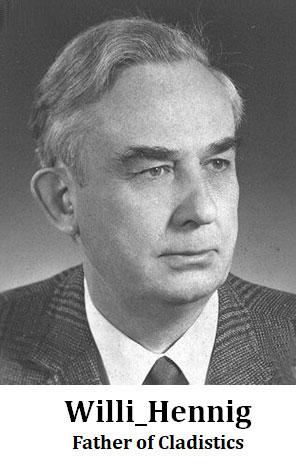
Ø He also introduced the key concepts in cladistics such as monophyly, paraphyly and polyphyly.
Ø In 1960 Peter Sneath and Robert Sokal introduced the concept of Numerical Taxonomy.
Ø Numerical taxonomy was a precursor to cladistics that used mathematical techniques to analyse phenotypic data.
Ø Although numerical taxonomy is distinct from cladistics, it contributed to the development of quantitative methods for analysing evolutionary relationships.
Advances in Molecular Biology
Ø The advent of molecular biology in the mid-20th century revolutionized the study of evolutionary relationships.
Ø DNA sequencing techniques allowed scientists to compare genetic sequences and infer phylogenetic relationships based on molecular data.
Ø This molecular revolution complemented traditional morphological and anatomical approaches, leading to the integration of genetic and morphological characters in cladistic analysis.
Key Concepts in Cladistics
To understand cladistics fully, it is essential to grasp several key concepts that underlie the methodology of cladistics. They are summarized below.
Monophyly, Paraphyly and Polyphyly
Monophyly
Ø A monophyletic group includes an ancestor and all of its descendants.
Ø In a cladogram, a monophyletic group is represented by a single branch starting from a common ancestor.
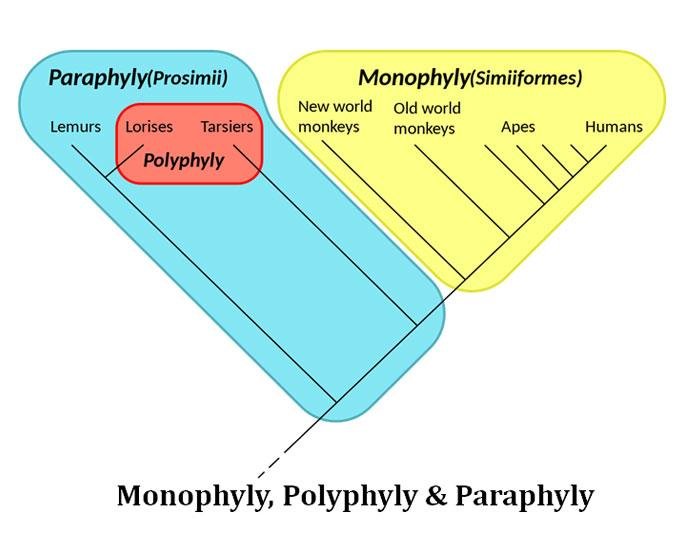
Paraphyly
Ø A paraphyletic group includes an ancestor and some, but not all, of its descendants.
Ø Such groups are considered unnatural and are discouraged in cladistic classification.
| You may also like NOTES in... | ||
|---|---|---|
| BOTANY | BIOCHEMISTRY | MOL. BIOLOGY |
| ZOOLOGY | MICROBIOLOGY | BIOSTATISTICS |
| ECOLOGY | IMMUNOLOGY | BIOTECHNOLOGY |
| GENETICS | EMBRYOLOGY | PHYSIOLOGY |
| EVOLUTION | BIOPHYSICS | BIOINFORMATICS |
Polyphyly
Ø A polyphyletic group includes members from different ancestral lineages but excludes their common ancestor
Ø Polyphyletic groups are also considered unnatural and are avoided in cladistic analyses.
Homology and Homoplasy
Homology
Ø Homologous characters are traits shared by a common ancestor and its descendants.
Ø These traits reflect evolutionary continuity and are crucial for constructing cladograms.
Homoplasy
Ø Homoplastic characters are traits that appear similar but do not share a common evolutionary origin.
Ø These characters can result from convergent evolution and they can complicate cladistic analyses.
Cladogenesis and Anagenesis
Ø Cladogenesis and anagenesis are two fundamental processes in the field of evolutionary biology.
Ø Both describe different patterns of evolutionary change within a lineage of organisms.
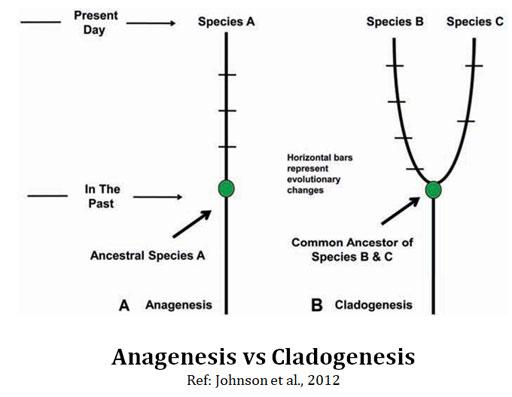
Cladogenesis
Ø Cladogenesis, also known as branching evolution or diversifying evolution.
Ø It refers to the process by which a single species splits into two or more distinct species.
Ø This occurs when a population of organisms undergoes significant genetic divergence, leading to the formation of separate evolutionary lineages.
Ø Cladogenesis is associated with the concept of speciation, which is the development of new and reproductively isolated species from a common ancestor.
Ø It is driven by various factors such as genetic mutations, geographic isolation, ecological specialization, and natural selection.
Ø The result of cladogenesis is the creation of a branching tree-like structure, called a phylogenetic tree.
Ø In this three each branch represents a separate species descended from a common ancestor.
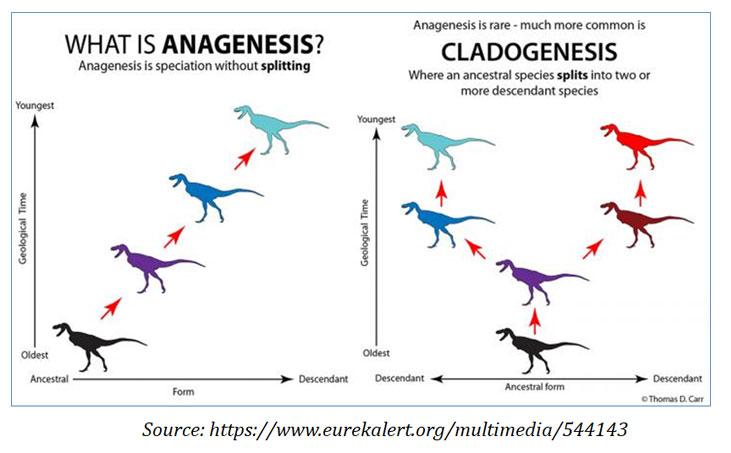
Anagenesis
Ø Anagenesis, also known as phyletic evolution or gradual evolution.
Ø Refers to the process of evolutionary change that occurs within a single lineage without the branching or splitting of species.
Ø Anagenesis describes the transformation of a population over time into a new or a modified version of the same species.
Ø Unlike cladogenesis, where new species are formed, anagenesis involves gradual changes in the characteristics of a population, leading to the accumulation of genetic and phenotypic differences from its ancestral form.
Ø Anagenesis can be driven by various mechanisms, including genetic mutations, natural selection, and environmental changes.
Ø Over time, these changes can result in a population that is significantly different from its ancestors, but there is no separate branching lineage involved.
Pleisiomorphic and Apomorphic Characters
Ø In cladistics, pleisiomorphic (or plesiomorphic) and apomorphic characters are terms used to describe certain types of characters or traits in the context of constructing phylogenetic trees and understanding evolutionary relationships among organisms.
Ø These terms are essential in determining the ancestral and derived character states.
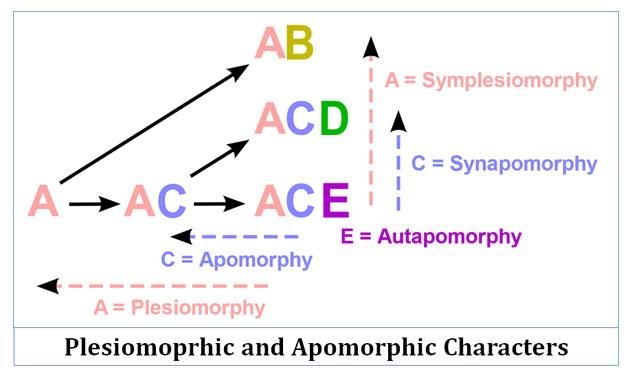
Plesiomorphic (Pleisiomorphic) Characters
Ø Plesiomorphic characters are also known as primitive characters or ancestral characters.
Ø They are traits that are shared among a group of organisms and are believed to be present in their common ancestor.
Ø These characters are relatively unchanged from the ancestral condition.
Ø These characters may be found in a broader range of organisms, including those outside the group of interest.
Ø Plesiomorphic characters are not useful for distinguishing relationships within the group under study.
Ø This is because they are shared with other lineages due to their ancient origin.
Apomorphic Characters
Ø Apomorphic characters are also known as derived characters or evolutionary innovations.
Ø These are traits that have evolved and changed from the ancestral state.
Ø These characters are unique to a particular group of organisms or a specific branch of the evolutionary tree.
Ø Apomorphic characters are often used in cladistics to identify and define monophyletic groups (clades) within a larger tree.
Ø These traits help researchers infer which species share a more recent common ancestor by looking for shared derived characters.
Ø Apomorphic characters are valuable for constructing cladograms because they provide information about the evolutionary relationships and branching patterns among organisms.
Outgroup Analysis
Ø Outgroup analysis involves including a taxon (outgroup) that is closely related to but outside the group of interest (ingroup).
Ø The outgroup helps root the cladogram by providing a reference point for identifying ancestral and derived characters within the ingroup.
Cladogram Construction
Ø Constructing a cladogram involves identifying shared derived characters (synapomorphies) among the taxa under investigation.
Ø These characters are used to create a branching pattern that represents the evolutionary relationships among the taxa.
Ø Cladistic software packages and algorithms assist in building cladograms based on character data.
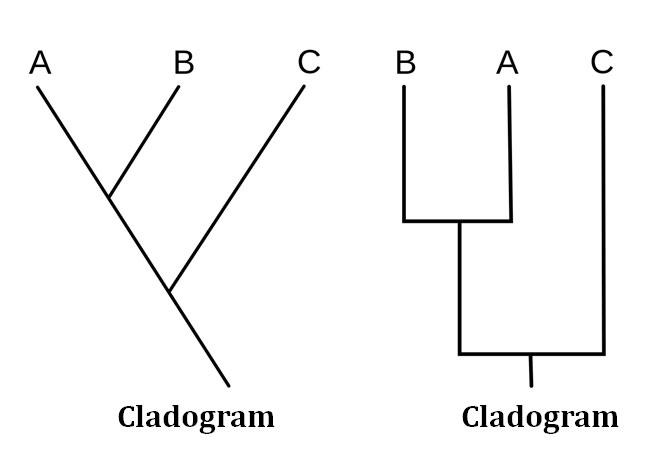
Applications of Cladistics
Cladistics has found applications in various fields of biology, including:
(1). Taxonomy and Systematics
Ø Cladistics has revolutionized the field of taxonomy by providing a rigorous and objective framework for classifying organisms based on evolutionary relationships.
Ø Taxonomists now use cladistic analyses to develop phylogenetic classifications that reflect evolutionary history.
(2). Molecular Phylogenetics
Ø The integration of molecular data into cladistic analyses has allowed scientists to construct phylogenetic trees based on genetic sequences.
Ø Molecular phylogenetics has resolved many long-standing questions about the relationships among species, genera, and higher taxonomic groups.
(3). Conservation Biology
Ø Cladistics plays a crucial role in conservation biology by helping identify evolutionarily distinct and threatened lineages.
Ø Conservation efforts often prioritize the protection of species or lineages with unique evolutionary histories.
(4). Biogeography
Ø Cladistics aids in the study of biogeography,
Ø It helps researchers to understand how organisms have dispersed and diversified across different geographic regions over time.
(5). Evolutionary Developmental Biology
Ø Comparative embryology and developmental biology benefit from cladistic analyses.
Ø which reveal patterns of developmental change and help elucidate the genetic basis of morphological evolution.
(6). Archaeology and Paleontology
Ø In paleontology and archaeology, cladistics is used to reconstruct the evolutionary relationships among extinct organisms and elucidate the origins of various traits.
Challenges and Controversies in Cladistics
While cladistics has revolutionized evolutionary biology, it is not without its challenges and controversies:
(1). Homoplasy and Convergence
Ø Homoplasy, or the independent evolution of similar traits in different lineages, can confound cladistic analyses.
Ø Distinguishing between homologous and homoplastic characters requires careful consideration.
(2). Missing Data
Ø Incomplete or missing data can limit the accuracy of cladistic analyses.
Ø Fossils often have incomplete preservation, making it challenging to identify diagnostic characters.
(3). Subjectivity
Ø The selection of characters and taxa, as well as the determination of character states, can introduce subjectivity into cladistic analyses.
Ø Researchers must exercise care to minimize bias.
(4). Model Assumptions
Ø Cladistic analyses are based on specific models of evolution, such as the assumption that evolution occurs through the acquisition and loss of characters.
Ø These assumptions may not always hold in all biological systems.
Conclusion
Cladistics is a powerful and versatile method for reconstructing evolutionary relationships among organisms. By identifying shared derived characters and constructing cladograms, scientists gain valuable insights into the history and diversification of life on Earth. Cladistics continues to evolve, incorporating molecular data and computational methods, and remains at the forefront of biological research. Despite challenges and controversies, cladistics stands as a cornerstone of modern evolutionary biology, guiding taxonomy, conservation, and our quest to unlock the secrets of life’s intricate web.
Important Questions?
- What is Cladistics? Who devised cladistics?
- Describe cladogenesis and its significance.
- Differentiate cladogenesis and anagenesis.
- Why is symplesiomorphy? What is its significance in cladistics?
- Differentiate homology and homoplasy.
- What is meant by outgroup analysis?
- How molecular biology revolutionized cladistic analysis?
- What are the applications and limitations of cladistics?
<<< Back to Evolution Notes Page
| You may also like NOTES in... | ||
|---|---|---|
| BOTANY | BIOCHEMISTRY | MOL. BIOLOGY |
| ZOOLOGY | MICROBIOLOGY | BIOSTATISTICS |
| ECOLOGY | IMMUNOLOGY | BIOTECHNOLOGY |
| GENETICS | EMBRYOLOGY | PHYSIOLOGY |
| EVOLUTION | BIOPHYSICS | BIOINFORMATICS |
| You may also like... | ||
|---|---|---|
| NOTES | QUESTION BANK | COMPETITIVE EXAMS. |
| PPTs | UNIVERSITY EXAMS | DIFFERENCE BETWEEN.. |
| MCQs | PLUS ONE BIOLOGY | NEWS & JOBS |
| MOCK TESTS | PLUS TWO BIOLOGY | PRACTICAL |
